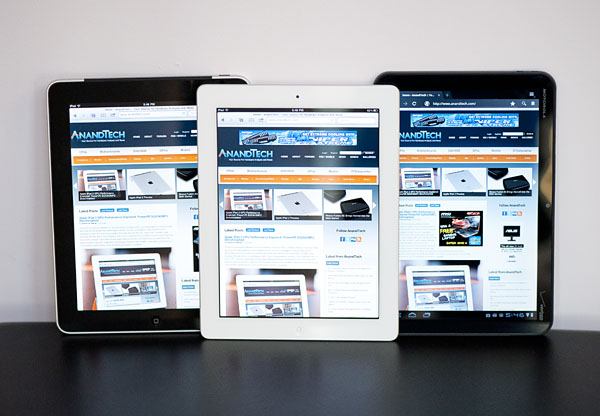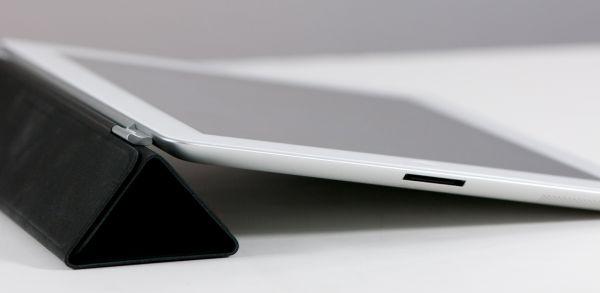Tablets: How Would You Solve the Input Problem?
by Anand Lal Shimpi on March 29, 2011 2:22 PM EST- Posted in
- Tablets
- Apple
- iPad 2
- Ask AnandTech
- Mobile
In our iPad 2 review I mentioned that despite really liking the device, I never really could integrate the original iPad into my daily life in a meaningful way. I always ended up traveling with the iPad and a notebook or while around town I just kept a smartphone on me. That limited my iPad use to pretty much lounging around at the house, and even then I found myself turning to the laptop more often than not.
With the Xoom and iPad 2 I've been giving the tablet usage model another try. I've kept my usage mostly consumption focused. Browsing the web and reading emails. I really do prefer using a tablet for both of these things. I do wish the iPad 2 was faster when selecting lots of emails but the improvement over the original iPad is still considerable.
My holdup is this: while I love reading on the iPad 2, I have troubles contributing using it. Writing lengthy email responses or even posting comments on AT is just slower on the iPad than on a notebook. The solution can't be to just walk over to a laptop when I want to respond and just use the iPad when I'm reading - that seems horrible inefficient.
I could use a Bluetooth keyboard but that's also rather clunky. I feel like there has to be a better solution going forward, particularly as the tablet market grows. Is it voice? Or some sort of an integrated kickstand with more flexibility than what you get with the smart cover?
I feel like smartphones get a pass because it's easy to type on them regardless of where you're sitting. Tablets on the other hand need to be propped up against something and as a result are harder to type on in certain situations. They work fine on a desk but if I'm at a desk I'd rather use a notebook. What about when laying back on a couch?
I'm curious what you all think about this. Am I alone in finding tablet ergonomics a barrier? If not, what do you believe is the best solution for tablets going forward. I want to read and respond on a tablet as quickly as I can on a notebook. What needs to be built? Post your comments here and I'm sure we can get many of the tablet manufacturers to pay attention. I don't think they have stumbled across the best solution for this problem either, so what you say here might go a long way in making tablets better for everyone.












247 Comments
View All Comments
GruntboyX - Tuesday, March 29, 2011 - link
I am thinking a stylus, and handwriting recognition. I know its not popular, but damn people wrote books for 100's of years with nothing but a quil. I would say instead of a keyboard popping up, a blank area to write would show, and you could use a stylus. On a tablet, the area could be big enough, not to produce the awkwardness that you were writing words in place.Maybe I am old...
purrcatian - Tuesday, March 29, 2011 - link
I second this.Tables have been used for quite a while in the business world as a data entry device. They always had handwriting recognition. There are still some being produced like the HP Slate 500.
I have always been interested in that type of tablet. I have come very close to purchasing one on several occasions. What I don't understand is these new consumption tablets. They seem completely useless.
A stylus is useful for a lot more than handwriting recognition. A stylus also allows for a more compact device and interface. I have an N900, and the stylus allows me to do all sorts of cool things. It makes the screen seem larger. Steve Jobs said that a tablet smaller than the iPad was pointless because finger are too big. He was partly right. Fingers ARE too big, but a small tablet can be very useful with a stylus. A tablet must be able to fit into a large pocket to be practical, and the only way it can remain useable at that size is a stylus.
Penti - Wednesday, March 30, 2011 - link
The point of the surftablets is that they are consumer devices, something the HP Slate failed to live up to entirely.Slate PCs, surf-tablets and ereaders are all different devices and surf-tablets are just MIDs done in a mainstream fashion, because we can now, they are powerful enough. Before there was so many limitations on entertainment, battery life, software, and touch screen tech. But for example the first e-readers in the 90's aren't so different to todays devices, they were just like a LCD-screen, touch enabled, embedded OS and some in devices books store. But they lacked wireless connection for internet, good multimediasupport and the cost was to high. Around double of todays devices and like 6 times more then todays e-readers like Kindle. Obviously the Nokia Internet Tablets like N810, N770 was a good solution in between when the tech wasn't really ready to be integrated into cell phones and wasn't really scaleable for larger screens. If you can't do high-res video, have 256 color screens and don't have a wireless connection they obviously aren't much of use, but we have that now in the cheapest possible SoCs and they are plenty of screens to choice from software for entertainment is there. Prices are in the range of consumers. That's really all why they are selling now. The technology is there for consumer devices. The world is mobile enough now. Content is there now. They obviously are consumer devices not productivity tools.
jah1subs - Tuesday, March 29, 2011 - link
Anand: The title of this message is meant to be a little off kilter. I am an individual for whom a full sized keyboard is the optimal data entry device. I am old enough that I doubt speech to text recognition -- with proper punctuation, as in this sentence -- will be useful in my lifetime. Maybe it will be when you are older. I have been hearing about speech recognition since almost the beginning of my career, and it is not here yet for continuous speech.There are some individuals who can read small characters on screens, who can tolerate screens with glare and who have exceptional fine motor skills. On those measurements, I am 0 for 3. Heck, I have trouble with my thumbs dragging on the touchpad on a laptop and try to carry a travel mouse at all times.
In my mind, a tablet makes a nice large TV remote for a Comcast app for those with the money (not me).
When I speak with people and tell them that I am too slow without a full sized keyboard, many of them admit that they use touch screens or small QWERTY keyboards but it slows them down too much.
I continue to believe that a laptop with a full sized keyboard, which probably means at least 12" widescreen display, but not as large as 15.6" because of weight and size considerations, is about optimal as a desktop substitute away from one's primary work location.
ados_cz - Tuesday, March 29, 2011 - link
Very good spoken word to written word recognition app cooperating with all to be written content and if word is not recognized, then tap to select option. What do you think?PsychoPif - Tuesday, March 29, 2011 - link
First, voice input should be better integrated in tablet. It came a long way since it's inception and it's the perfect input when you got both hand handling a 10" device. Just say what you want to write, then come back on the words the system missed with some kind of word correction tool like on smartphones.I think the stylus is also underrated. It's a lot more precise than fingers and in 2011, everyone should be able to write. I think all the touch friendlyness is kind of gimicky. We are here today because our chimp ancestor used rocks and sticks instead of their hands, why on earth do we want to go back? Tools exist for a reason and a small stylus can be cleanly integrated in a tablet.
In conclusion, if your solution to bad tablet input is any kind of hardware keyboard, think for a second what a laptop is if not a screen with a keyboard? What's the difference between a tablet with a keyboard in the cover and a notebook with a touch enable screen...
gseguin - Tuesday, March 29, 2011 - link
I'd engeneer a specialised bluetooth keyboard that would 'clip-on' magnetically to the ipad for storage and travel.Although you would use your tablet for reading most of the time with the keyboard at home or in the hotel room, when you know you're going to need the extra input device you clip it on and bring it along.
So on the plane if you're reading an e-book, the kb is in your hand bag, but when you put everything away, you don't want a standard keyboard floating around in there, hence the need for a newly built device.
For on the go, I believe swipe would not be as useful on a device meant to use both thumbs.
MrJawbones - Tuesday, March 29, 2011 - link
I just bought an iPad (original for $100 cheaper) and I found the Zaggmate case for $75. The iPad fits right into the Zaggmate which only adds ~1/4 inch to the thickness. You get a case, keyboard, and stylish look and the iPad isn't "stuck" in the case like it is with all of these leather case/keyboard combos. You can take it out and if you don't need the keyboard just pick up the iPad and go. It's the best of both worlds in my book.Now, just need an InvisibleShield to protect the back and I'm all set!
MrJawbones - Tuesday, March 29, 2011 - link
Oh, and it's also a great stand. The reason it's imperfect is because of the plastic stand that holds the iPad up. You have to take it completely out, put up the plastic stand, flip around the iPad (so the volume controls face upwards) and put it on the stand. It would be much better to just pull up the iPad and have some sort of spring loaded stand to hold it up.But it's not a "deal breaker" for me.
Mumrik - Tuesday, March 29, 2011 - link
I would attach a compact keyboard and put much faster hardware in it. The keyboard would be attached in such a way that it could be flipped close to the screen protecting both keyboard AND screen at the same time.I would call this revolutionary device - A LAPTOP!
Thank you, thank you. It seems like the natural next step.